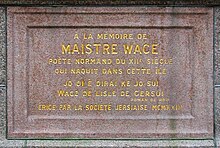This article has multiple issues. Please help improve it or discuss these issues on the talk page . (Learn how and when to remove these messages)
|


Roman de Rou ("Romance of Rollo") is a verse chronicle by Wace in Norman covering the history of the Dukes of Normandy from the time of Rollo of Normandy to the Battle of Tinchebray in 1106. It is a national epic of Normandy.
Contents
Following the success of his Roman de Brut , which recounted the history of the Britons, Wace was apparently commissioned by Henry II of England to write a similar account of the origins of the Normans and their conquest of England. Wace abandons his tale before bringing it up to date. He tells the reader in the final lines of Part III, that the king had entrusted the same task to a Maistre Beneeit (believed to be Benoît de Sainte-More).
The work was started in the year 1160, and Wace seems to have performed his last revisions in the mid-1170s.